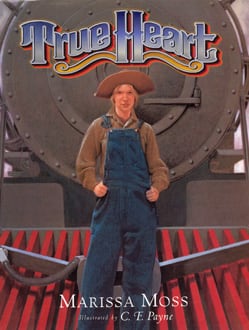
True Heart
March 1999
Description
Since age sixteen, Bee has loaded freight for the Union Pacific Railroad, all the while dreaming of being an engineer. Bee loves the railroad: from the roar and clatter of the wheels against the track to the names like True Heart, Roaring Wolf, and Coyote Special to the low blast of the whistle-whoooo-whoooo. Then one day, Bee gets the chance to drive the True Heart all the way from Cheyenne to Chicago. A seamless mix of history and fiction, True Heart is a story of the American frontier, of wanting something so much you can’t think of anything else–and of the little-known work of pioneer women who made the American railroad a reality.
Reviews
From Publishers Weekly, starred review
Moss (Rachel’s Journal: The Story of a Pioneer Girl; Amelia’s Notebook) uses her flair for capturing girls’ voices to tell a remarkable and exhilarating story. A turn-of-the-century photograph of an all-women work crew for a railroad inspired this tale of a teenager’s first time driving a train, an experience that launches her career as an engineer. Newly orphaned in 1893, 16-year-old Bee takes a job loading freight on the railways to support her eight siblings. Moss evokes the love of trains that keeps Bee in the engineer’s cab every spare moment, watching and asking questions, and her joy at driving for the first time, when an injured engineer and a trainful of impatient passengers pressure the station manager to give her a chance. On the final spread, Bee recalls that inaugural experience: “I felt so free and strong, galloping across whole states in my iron horse, blowing my whistle for all the sky to hear.” For his first children’s book, Payne uses mixed media in a crisp, realistic style. He so meticulously defines the action that the illustrations seem frozen in time, oddly tranquil: unexpected angles and tight close-ups create arresting compositions. This book will be welcomed by a wide audience: train lovers, frontier buffs, all girls, and any adult who, like Bee, can “remember wanting something so much you can’t think of anything else.” Ages 5-9. Copyright 1999 Reed Business Information, Inc.
From School Library Journal
Grade 2-4-An engineer for the Union Pacific at the turn of the century reminisces about the event that made the dream of driving trains become a reality. As a freight loader, Bee took every opportunity to sit in the cab and watch the engineers work, and was occasionally offered a chance to drive from one station to the next. One day on a run from San Francisco to Chicago, a group of bandits shot and injured the engineer at the controls. Bee volunteered to complete the run and the station manager agreed, marking that day as the start of a new career for Bee. This comfortably paced story has a familiar feel to it and a secret that will disclose itself to attentive readers: Bee is a woman. The use of nicknames throughout and an avoidance of gender pronouns draw the attention to the heart of the story-Bee’s dream-rather than her sex. Accompanying the author’s note at the end of the book is a black-and-white photograph of a group of female freight loaders that inspired this book. The mixed-media illustrations are realistic but softened with sepia tones, as if with age; and except for a couple of double-page spreads, full-page illustrations on the right face text on faux-stained parchment backgrounds. Visually and textually, this quiet story is a treasure. Nina Lindsay, Oakland Public Library, CA Copyright 1999 Reed Business Information, Inc.
From Parents’ Choice®
Based on historical facts, this handsomely-illustrated picture book is about dreaming and “wanting something so much you can’t think of anything else.” In this instance, the dreamer is a sixteen-year-old girl from Cheyenne whose unlikely ambition, in 1893, is to become an engineer on a train. (Young women, surprisingly, were often hired as freight loaders, but never as engineers.) How the heroine, Bee, works to make her dream come true is the substance of this absorbing story about the special role that trains played in the settling of the West. One minor quibble is that the illustrator’s convincing pictures do not make it clear enough that Bee and her work crew are girls. An interesting sidebar to American history. (Selma G. Lanes, Parents’ Choice®, 2000)
From Kirkus Reviews
A deeply satisfying story of longing and hard work fulfilled, inspired by an obscure historical photograph. Bee loves the railroad: the sound and color, the sweep past the wide world into the cities, the wonderful engine names, such as True Heart and the Coyote Special. When her parents die, she finds that, with eight siblings to care for, loading freight for the Union Pacific in Cheyenne in 1893 pays far better than taking in wash. She’s strong, and gets hired to load the trains. But what Bee loves most is to pepper Ole Pete, the engineer, with questions; he lets her drive the train a bit, back it up, and couple it to other cars. When Bee gets the chance to drive a train, she takes two of her female crew to stoke the engines, “blowing my whistle for all the sky to hear.” The language is homespun and direct, with Bee’s desire and love for the railroad clear. The text faces the full-page illustrations; occasional double-page spreads float the text on top of the image, as in one dramatic scene where ghostly wagon trains parallel the train on its run. The mixed media paintings have a burnished quality, while the textures are beautifully tactile. The text never mentions Bee’s gender, but Moss provides a note about her inspiration and preserves another tessera from the mosaic of women’s history. A rousing and romantic tale. (Picture book. 5-10) — Copyright ©1999, Kirkus Associates, LP. All rights reserved.
